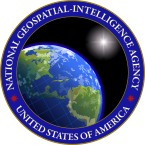National Geospatial Intelligence Agency

Seal of the U.S. National Geospatial-Intelligence Agency
|
|

Flag of the U.S. National Geospatial-Intelligence Agency
|
|
 NGA Campus East is the headquarters of the agency. The building features trapezoidal windows, color-coded interior sections, and is bisected by an atrium that is large enough to hold the Statue of Liberty. |
|
| Agency overview | |
|---|---|
| Formed | October 1, 1996 (as the National Imagery and Mapping Agency) |
| Preceding agency |
|
| Jurisdiction | U.S. Department of Defense |
| Headquarters |
Fort Belvoir, Springfield, Virginia, U.S. 38°45′12″N 77°11′49″W / 38.7532°N 77.1969°WCoordinates: 38°45′12″N 77°11′49″W / 38.7532°N 77.1969°W |
| Motto | "Know the Earth... Show the Way... Understand the World" |
| Employees | About 16,000 |
| Annual budget | Classified (at least $4.9 billion, as of 2013) |
| Minister responsible | |
| Agency executives |
|
| Parent agency | Department of Defense |
| Website | www |
| Footnotes | |
The National Geospatial-Intelligence Agency (NGA) is both a combat support agency under the United States Department of Defense and an intelligence agency of the United States Intelligence Community, with the primary mission of collecting, analyzing, and distributing geospatial intelligence (GEOINT) in support of national security. NGA was known as the National Imagery and Mapping Agency (NIMA) until 2003.
NGA headquarters, also known as NGA Campus East, is located at Fort Belvoir in Springfield, Virginia. The agency also operates major facilities in the St. Louis, Missouri area, as well as support and liaison offices worldwide. The NGA headquarters, at 2.3 million square feet (214,000 m2), is the third-largest government building in the Washington metropolitan area after The Pentagon and the Ronald Reagan Building.
In addition to using GEOINT for U.S. military and intelligence efforts, the NGA provides assistance during natural and man-made disasters, and security planning for major events such as the Olympic Games.
U.S. mapping and charting efforts remained relatively unchanged until World War I, when aerial photography became a major contributor to battlefield intelligence. Using stereo viewers, photo-interpreters reviewed thousands of images. Many of these were of the same target at different angles and times, giving rise to what became modern imagery analysis and mapmaking.
The Engineer Reproduction Plant was the Army Corps of Engineers's first attempt to centralize mapping production, printing, and distribution. It was located on the grounds of the Army War College in Washington, D.C. Previously, topographic mapping had largely been a function of individual field engineer units using field surveying techniques or copying existing or captured products. In addition, ERP assumed the "supervision and maintenance" of the War Department Map Collection, effective April 1, 1939.
...
Wikipedia
